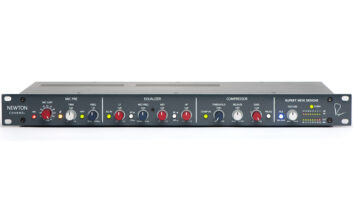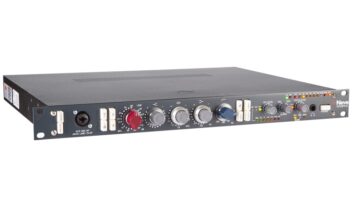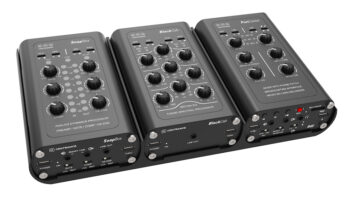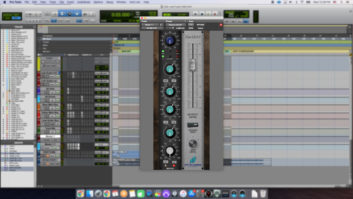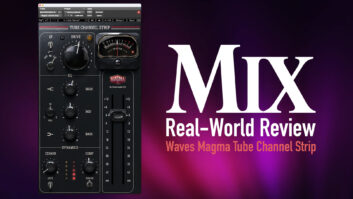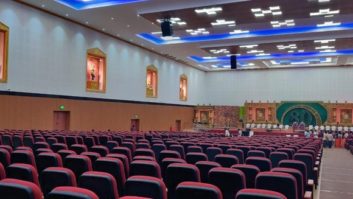
The AMS Neve 8801 continues a recent, exciting trend in which select manufacturers produce rackmountable channel strips based on their large-format consoles. AMS Neve’s single-channel 8801 ($3,250) takes key sections of the 88R mixing console, with the transformer-coupled mic preamp sections said to be identical. Comprehensive and ultraflexible filter, dynamics and EQ sections join the 8801’s preamp to create a jack-of-all-trades processor.
LOADED TO THE GILLS
I haven’t seen an analog processor fit so much functionality into a 1RU front panel, and the 8801 does so with very few ergonomic compromises. Rotary controls are continuously variable, and the EQ section’s gain and Q controls offer center detents. All but six of the 22 rotary controls can be pushed to activate alternate functions, whose status is indicated by bright LEDs, and titling of several intermediate parameter values for most knobs (with few exceptions) is afforded without confusing the eye. The unit’s 11 pushbutton switches are brightly backlit.
An XLR/¼-inch TRS combo jack on the front accepts balanced mic or balanced/unbalanced DI input. This jack is wired in parallel with XLR mic and TRS DI jacks on the rear. An additional XLR connector on the back accepts balanced or unbalanced line input. The manual briefly mentions an optional daughter card that can be installed to accommodate digital input; additional information was not available at press time. You can cycle through mic, line, DI and digital inputs by successively pressing the input gain knob. Maximum input and output levels are +26 dBu; DI input capability tops out at +20 dBu.
The input gain control produces +20 to +70 dB of gain for mic input or -24 to +24 dB for line or DI input. A switch for a 20dB pad serves the front panel combo mic/DI jack but is not intended for use with high-impedance instruments; when DI input is selected, activating the pad lowers the input impedance from 750k ohms to 100k ohms to optimally buffer a line-level signal inputted via the combo jack. A switch for 48-volt phantom power serves only the mic input, while a phase-inversion switch serves all inputs.
The HPF (whose corner frequency can be set from 30 to 300 Hz) and lowpass filter (1.5 to 18 kHz) immediately follow the input section. The filters can be independently activated and routed together to the audio path or the dynamics section’s sidechain.
The dynamics section includes a compressor/limiter and a gate/expander/ducker, each with their own controls and separate 5-stage LED meters that show gain-reduction amounts. Separate rotary controls for makeup gain, threshold, ratio and release serve the compressor/limiter, which provides soft-knee action by default. The knobs for these controls can be pressed to activate hard-knee, link (to compressors in other 8801 units), fast attack and auto- (program-dependent) release functions. Bypass the compressor by setting its threshold to +20 dBu and ratio to 1:1.
Rotary controls for the gate/expander/ducker include hysteresis, threshold, range and release. (Set the range control to 0 dB to bypass the gate/expander/ducker.) The value of the hysteresis control (variable from 0 to 25 dB) is added to that of the threshold control to determine when signals rising in level will turn on, whereas the threshold alone determines when falling levels are turned off. This helps prevent the gate from chattering on and off when signal levels fluctuate around the threshold. While the default operation in this section is gating, two of the rotary knobs can be pressed to activate expander or ducker action. Pressing two other knobs in this section activates key input and initiates faster attack time, respectively. A D-sub connector on the rear panel provides connections for key input to the gate/expander/ducker and compressor linking. The excellent owner’s manual details the pin-out configuration. Currently, users must supply their own breakout cables.
THAT’S A SWITCH
The 4-band EQ includes HF and LF bands that can each be switched to provide either shelving or bell-curve response; the latter setup offers switchable Q values of 0.7 and 2. The two middle bands are fully parametric, including rotary Q controls varying in value from 0.4 to 10. Up to 20 dB of boost/cut is available to each band. Frequency ranges are 33 to 440 Hz (LF band), 120 to 2k Hz (lo-mid), 800 to 9k Hz (hi-mid) and 1.5 to 18 kHz (HF). The entire EQ section can be placed in either the audio or dynamics sidechain path.
An ingenious, user-friendly audio router lets you view and reorder the position in the audio path of the downstream dynamics and EQ sections, and rear panel XLR inserts in mere seconds. You can also independently bypass the dynamics, EQ and inserts. The rotary output gain control’s range is -∞ (mute) to +10 dB. Pressing on the knob for this control toggles an associated 7-stage, multicolored LED meter between showing input and output levels. Backlit buttons light red to indicate overload in the input, dynamics, EQ or insert stage, or in an option board that provides A/D conversion. The 8801’s power supply is external, lump-in-the-line.
COMPUTER CONTROL
An XLR line output, ¼-inch TRS headphone output and USB port join previously mentioned rear panel input connectors. The USB port can be linked to a PC or Mac. Up to 16 “88 Series” units, including the 8801, can have their current state stored, named and later recalled using the included AMS Neve 8801 Channel Strip/AMS Neve Recall software and this port. Minimum system requirements are Windows 2000 SP4 or XP SP2 or later (PC) and Mac OS 10.3.9 or later. When you recall a setup, the software automatically restores all switch settings and shows you to which position the rotary controls must be manually moved to duplicate their stored settings. You can also drag and drop virtual processing blocks and inserts in the GUI to quickly add them to or remove them from the audio path (or the sidechain where allowed). Individual 88 Series units may be removed from a system-wide recall for stand-alone operation.
The AMS Neve Recall software was a breeze to install and immediately recognized the 8801 — connected to my Mac’s USB hub — after launching. I was happy to note that the software’s excellent GUI is bi-directional, mirroring any real-time control changes (including rotating continuously variable controls) I made on the 8801 itself. As I matched the setting for each control to its stored value in a Recall file, the GUI confirmed the match, eliminating any doubt. On the downside, the 8801’s current switch settings are lost on powering down. Save your setups often — the Recall software occasionally freezes. [According to the company, this can occur if the unit is connected to an unpowered USB hub. — Eds.]
The optional A/D card ($900) breaks out on the unit’s rear panel and features an A/D converter; AES, S/PDIF and DSD outputs; AES 3-format sync input; and word clock I/O. The card supports internal and external synchronization to standard sampling frequencies from 44.1 to 192 kHz. The A/D converter can output at twice the sampling rate it receives at its sync input. DSD output is switchable between SDIF-2 and SDIF-3 formats.
TAKING IT THROUGH ITS PACES
The 8801 sounded great on an electric guitar cabinet miked with a Royer R-121. I intentionally clipped the channel strip’s pre to add some full-bodied hair to the sound. Moderately boosting midrange frequencies and employing low-shelving cut in the EQ section helped the sound cut through a dense production; further sculpting with the HPF and LPF gave the resulting track its own frequency “window” for the mix. I was disappointed that the compressor’s makeup gain stage only boosts and not attenuates levels. I would have preferred to drive the preamp hard, set the compressor to 1:1 ratio and lower the output level of the compressor to preserve headroom in the downstream EQ section. Nevertheless, the sound still rocked.
Plugging a passive electric bass guitar into the 8801’s DI input, the sound was restrained and “closed in.” I surmised this was due to the pickups being loaded by the DI input’s unusually low input impedance. The input stage also didn’t offer enough gain to overdrive the preamp with this relatively quiet instrument. I got similarly dull and lifeless results on a DI’d vintage Strat.
Activating the compressor with a 3:1 ratio and suitably long release time caused no pumping on electric bass with 5dB gain reduction. But when set to a very short release time, the comp acted strangely on a singer holding a long note — the gain-reduction amount would repeatedly and quickly drop and recover, causing very short and artificial-sounding 3dB spikes in output level. I tested a second 8801 and noted the same problem.
The compressor worked great as a vocal de-esser. I set this up by routing the EQ section to the dynamics sidechain, cranking high-shelving EQ and cutting low-shelving, and using the fastest-possible compressor attack and release times. Set up thus or with the compressor bypassed, vocals sounded wonderfully round, soft and warm.
When routing a “cardboard-y”-sounding kick track and lifeless snare track in turn to the 8801’s rear panel line input and intentionally overdriving the preamp stage, the results were pretty remarkable. The kick sounded noticeably meatier and the snare had much more crack to it. On the kick track, the compressor reigned in the drummer’s wild dynamics, and the expander tightened the decay nicely and cleaned up the mic bleed. Routing a bass guitar track into the 8801’s line input created a much bigger and warmer sound, and a little 8801 EQ cut at 1 kHz deftly moderated the somewhat piano-like tone caused by the player using a plastic pick.
A MIXED BAG
The 8801’s mic and line input stages sound fantastic, and its EQ section is wonderfully musical. The audio router and included Recall software are also terrific assets. For such a pricey unit, however, I wish the compressor had more personality and wasn’t so glitchy. The DI input could also sound a lot better. These shortfalls aside, the 8801 is a great-sounding box.
AMS Neve,
www.ams-neve.com.
Mix contributing editor Michael Cooper is the owner of Michael Cooper Recording in Sisters, Ore. Visit him at
www.myspace.com/michaelcooperrecording.
